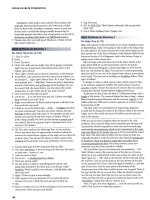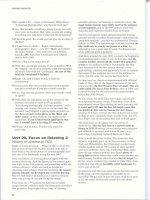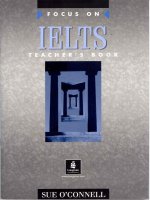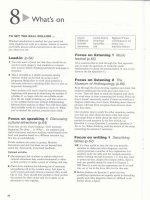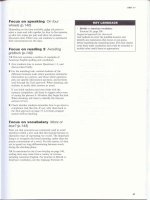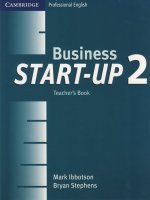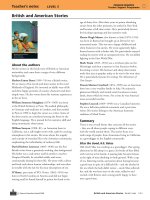Achievers a1+ teacher book pluspdf
Bạn đang xem bản rút gọn của tài liệu. Xem và tải ngay bản đầy đủ của tài liệu tại đây (20.81 MB, 371 trang )
Teacher’s Book
A1+
Terry Prosser
Richmond đ
58 St Aldates
Oxford OX1 1ST
United Kingdom
â 2016 Richmond/Santillana Educaciún, S.L.
Additional material by Patricia Chappell
Publisher: María Lera
Senior Commissioning Editor: Tom Hadland
Managing Editors: Ruth Goodman, Catherine Richards
Editorial Team: Brígido Adán Lozano, Stephanie Bremner, Ben Pincus, Paloma Rodríguez Esteban
Cover Design: Marisela Pérez
Design: Dave Kuzmicki, Colin Stobbart
Photo Research: Magdalena Mayo
To consult the credits for the material reproduced here, refer to Achievers A2 Student’s Book.
Printed in Spain
ISBN: 978-84-668-2962-5
CP: 657487
DL: M-7987-2016
All rights reserved.
No part of this work may be reproduced, stored in a retrieval system or
transmitted in any form, electronic, mechanical, photocopying or
otherwise without the prior permission in writing of the Publisher.
Every effort has been made to trace the holders of copyright,
but if any omissions can be rectified, the publishers will be
pleased to make the necessary arrangements.
TOEFL Junior® is a registered trademark of Educational Testing Service (ETS).
This product is not endorsed or approved by ETS.
The publisher would like to thank all those who
have contributed to the development of this course.
Teacher’s Book
Terry Prosser
A1+
Introduction and course highlights ................................................... page 2
Student’s Book ................................................................................................. page 4
Exam preparation with Achievers ....................................................... page 8
Workbook .......................................................................................................... page 10
Teacher support ............................................................................................ page 12
Teacher’s i-Book ............................................................................................ page 14
Student’s Book contents .......................................................................... page 16
Starter A, B, C and D .................................................................................... page 18
Unit 1 – Free time ......................................................................................... page 30
Unit 2 – School is cool! .............................................................................. page 56
Unit 3 – Party time! .................................................................................... page 82
Review – Units 1-3 ..................................................................................... page 108
Unit 4 – Wonderful world .................................................................... page 114
Unit 5 – Let’s go out .................................................................................. page 140
Unit 6 – Long ago ....................................................................................... page 166
Review – Units 4-6 .................................................................................... page 192
Unit 7 – Wild world .................................................................................. page 198
Unit 8 – Getting away ............................................................................. page 224
Unit 9 – Digital world .............................................................................. page 250
Review – Units 7-9 .................................................................................... page 276
Review – Units 1-9 .................................................................................... page 282
Grammar Reference ................................................................................ page 301
Prepare for Cambridge Exams .......................................................... page 310
Prepare for the TOEFL Junior® Test ................................................ page 312
Stories .............................................................................................................. page 352
Face 2 Face .................................................................................................... page 360
Pronunciation ............................................................................................. page 361
Communication ......................................................................................... page 366
ACHIEVERS
Achievers is a multi-level course aimed at
ambitious teachers who want their teenage
students to achieve their very best in English.
Achievers aims to motivate and challenge
students at every step of the learning process.
Each Achievers unit has a number of key features
which make the course unique:
LARGE VOCABULARY SETS
Achievers has an ambitious vocabulary and
grammar syllabus and contains thorough and
regular practice of all the key skills – Reading,
Listening, Speaking and Writing.
Achievers has a full component package
including:
●
Student’s Book
● Workbook
● Teacher’s Book
The Vocabulary lessons contain large numbers of items, both
revised and new, higher level items, which consolidate and
extend students’ personal vocabulary.
containing complete teaching notes
and reference material
EXAM PREPARATION
● Teacher’s i-book
for interactive whiteboards
● Teacher’s Resource Book
containing a complete pack of photocopiable
tests and activities as well as further
supplementary worksheets
● Teacher’s Audio Material Pack
containing all the audio for the course
on six CDs
Every unit has Cambridge and TOEFL® exam preparation
lessons based on the language learnt in the unit.
FAST FINISHERS
Every Achievers unit contains four varied Fast Finishers to keep
stronger students busy.
2
COURSE HIGHLIGHTS
WORD ZONE
Each Reading lesson features Word Zone, which focuses on a
useful vocabulary building area seen in a natural context.
LISTENING
A whole page of Listening helps develop this crucial skill, with
challenging, substantial listening situations.
FACE 2 FACE
REGULAR SPEAKING ACTIVITIES
All lessons include speaking activities to allow students to share
their prior knowledge of topics, to reflect on them afterwards,
and to practise new language.
CHALLENGE
The unique Challenge lesson gives students the chance to
prepare and carry out a variety of enjoyable and ambitious
speaking tasks.
Face 2 Face pulls out common idiomatic spoken language
featured in the Listening scripts.
3
Student’s Book
STARTER LESSONS
● There are four optional Starter lessons at the start of the
Student’s Book – Starter A, B, C, D. They give an introduction to the
methodology of the main units, and contain basic grammar and
vocabulary that students at this level should be familiar with.
● Use as many or as few of the Starter lessons as you feel necessary
for your students, depending on which language areas you wish to
revise. The lessons are self-contained, and can be used in any order.
UNIT WALKTHROUGH
Reading
● There are two Reading texts per unit.
● The texts are substantial and cover a variety of modern, relevant
text types such as online blogs, websites, articles and stories.
● The Reading texts are exploited with challenging comprehension
activities and oral and personalized follow-up activities.
1
Each Reading lesson contains
a Word Zone, which highlights
a vocabulary area featured
in the text such as phrasal
verbs, collocations and set
expressions.
1
2
Vocabulary
● The two main vocabulary sets per unit are large – often
consisting of 20–30 items – and contain both familiar and
new, higher level items, to consolidate and extend students’
personal vocabulary.
● The vocabulary is practised through a variety of activities,
including oral and personalized activities.
4
2
Extra interactive
practice
STUDENT’S BOOK
Grammar
● There are two Grammar
sections, each containing a
grammar box with a summary
and examples of the grammar
area being dealt with. An
irregular verb list is also
included at the back of the
book.
1
●The Grammar Reference is also
available on the Teacher’s
i-book as Visual grammar
presentations – an animated,
step-by-step presentation.
● The lessons always contain
oral practice to allow students
to practise the language in a
spoken context and learn the
correct pronunciation.
● The language is practised in
a variety of carefully staged
activities.
Listening
3
2
4
1
A complete Grammar
Reference with detailed
explanations of each
grammar area can be
found at the back of the
book.
2
Extra interactive practice
3
Common spoken language
is exploited in Face 2
Face – students learn to
recognize three idiomatic
expressions in each lesson
that often occur in spoken
English.
4
There is also a freer,
follow-up interactive
activity where students
produce their own version
of the dialogues or give
their opinions on
a related topic.
● Each Listening section contains substantial and
challenging listening input to really stretch students
and develop their listening skills.
● A variety of real-world situations are featured,
including radio interviews, sports commentary,
cookery shows and game shows as well as everyday
conversations.
Challenge
● The Challenge lesson asks students to work in pairs or groups to
prepare and carry out an ambitious, fun speaking task that builds
on language learnt during the unit.
● Each Challenge lesson has a totally different task. It will feel fresh
and motivating.
● The Challenge lessons are in three stages: Preparation, Do The
Challenge, and Follow Up. Students have the opportunity to stretch
their skills as much as possible.
5
STUDENT’S BOOK
Interaction
● The Interaction lessons feature
three school friends who live in
the UK in a variety of everyday
situations.
3
1
● Students are given prompts or
role-cards to stimulate their
speaking, rather than entire
dialogues. This gives them the
autonomy that is necessary in
developing the speaking skills.
1
4
2
Common expressions from
the situations are given in
the Express yourself box.
This features language that
students will need to both use
and understand in order to
interact successfully.
Writing
2
Students listen to
the situations, focus
on specific language
commonly used in each
situation, and then have
the chance to interact
themselves in Your Turn To
Speak.
● In the Writing section, students
work through a model written
text, and then write their own
version.
3
4
Writing skill focuses on
an important language
area that students need
to master, in order to
improve their ability to
produce good written
texts.
Unit Reviews
● Each unit has an End-of-Unit
Review which revises the key
grammar and vocabulary.
● The audio for each Dictation has
built-in pauses to allow students
to write as they listen.
1
6
Each End-of-Unit Review
finishes with a Dictation. This
is a paragraph on a subject
related to the topic of the
unit. Each Dictation becomes
progressively longer towards
the end of the book.
1
In Your Turn To Write,
students are guided
step-by-step through the
critical stages of planning,
taking notes, writing and
checking that are needed
to produce their own text.
STUDENT’S BOOK
Three-Unit Reviews
1
● There are Three-Unit Reviews
after units 1–3, 4–6 and 7–9. They
revise grammar and vocabulary
from the previous three units in
a fresh context.
● Each Three-Unit Review
contains practice of all the
key skills. They consist of a
substantial reading text, a
listening section, and a followup speaking or writing section.
2
Video
● Each video contains an original short documentary
which introduces a different English-speaking country
from around the world.
● Students are introduced to some names, places or other
cultural information before they watch. They find out
the significance of these, and as well as learning more
interesting information about each country.
1
There is a video lesson
after each Three-Unit
Review. In this section,
students develop their
skills in watching and
understanding video, which
will increase their ability
to enjoy English-language
films and TV.
2
Each video lesson ends
with Find Out, where
students have the chance
to find out more about
an intriguing aspect of
the country’s culture that
featured in the video.
Stories
● Each Student’s Book contains
three original stories. They
have been specially written
for Achievers, with teenage
protagonists, and deal with
themes from the Student’s Book.
● The stories are rich in new
vocabulary. They contain
comprehension activities,
vocabulary exploitation and
follow-up speaking activities in
order for students to exploit them
as much as possible.
7
Exam preparation with Achievers
This section is aimed at teachers who are preparing their
students for exams from the Cambridge English Language
Assessment range or from ETS. Each level of the Achievers
series focuses on the most appropriate exams for the level
of the book, so Achievers A1+ prepares students for the
Cambridge Key (KET) exam and for both the Standard and
Comprehensive versions of the TOEFL
Junior® Test.
The Cambridge Key (KET) exam and the TOEFL Junior® Test
are internationally recognized qualifications
in English.
Prepare for Cambridge Exams
● There are nine lessons in the Student’s Book – one per
unit – covering the Cambridge Key exam. The content
of the lessons follows the unit topics, so the lessons feel
integrated and can be covered at any point during a unit.
● Each lesson focuses on a particular task from one of the
papers of the exam; there is a balance of tasks from all
sections of the exam throughout the section. There is a
series of activities carefully designed to give them practice
in the skills they need to perform the task well, and
familiarize them with the format of the task.
● The language level required to complete the activities is
the level of the corresponding Student’s Book unit.
●The Workbook contains a complete page corresponding
to each Student’s Book exams lesson, consisting of further
practice of the task focused on in the Student’s Book.
● There is accompanying audio for Listening tasks.
3
1
2
An exam-style activity at the
end of each lesson. Students
attempt this once they have
learnt about and prepared
for the task. They could do
this under exam conditions.
1
2
Help and advice to allow
students to maximize their
performance
3
8
Key information about
the task focused on in
this lesson
EXAM PREPARATION
Prepare for the TOEFL Junior® Test
● There are nine lessons in the Student’s Book – one per
unit – covering both the Standard and Comprehensive
versions of the TOEFL Junior Test®. The content of the
lessons follows the unit topics, so the lessons feel
integrated and can be covered at any point during
a unit.
● Each lesson focuses on a particular task from one of
the papers of the Test; there is a balance of tasks from
all sections of the exam throughout the section. There
is a series of activities carefully designed to give them
practice in the skills they need to perform the task well,
and familiarize them with the format of the task.
● The language level required to complete the activities is
the level of the corresponding Student’s Book unit.
●The Workbook contains a complete page
corresponding to each Student’s Book exams lesson,
consisting of further practice of the task focused on in
the Student’s Book.
● There is accompanying audio for Listening tasks.
3
1
2
An exam-style activity at the
end of each lesson. Students
attempt this once they have
learnt about and prepared
for the task. They could do
this under exam conditions.
2
1
Help and advice to allow
students to maximize their
performance
3
Key information about
the task focused on in
this lesson
9
Workbook
The Workbook provides practice of all the Student’s Book material for students to do
at home or in class. Every lesson in the Student’s Book has a corresponding page of
Workbook practice, on the same page number, for easy reference.
Starter lessons
2
● The grammar and vocabulary
from each Starter lesson are
consolidated in the Workbook
Starter pages.
Units 1–9
● Every language and skills
area from the Student’s Book
including the exams sections,
has a corresponding Workbook
page, which gives further
practice of the language or skill
in question.
● Student’s audio is provided
for Listening and Interaction
lessons, for students to continue
developing the listening skill
at home. Students access the audio
material to listen or download on
the Achievers website.
● Each unit contains a Webquest,
where students can find out
more about topics featured in the
Student’s Book units online.
Three-Unit Reviews
● The grammar and vocabulary
from the previous three units is
pulled together in a number of
activities that provide intensive
language revision.
Video
● Students watch a new video
related to a cultural aspect of the
country featured in the Student’s
Book Video section. They
follow up by researching more
interesting aspects of the topic
to share with their classmates.
10
1
1
Word Zone Extra:
Consolidation and
extension of Word
Zone in the
Student’s Book
2
Want To Know More?:
A vocabulary extension
section with a new set
of vocabulary, related to
the Student’s Book set,
appearing twice per unit
WORKBOOK
End-of-Unit Reviews
Exams
● Students revise grammar and vocabulary from each unit
through a fun crossword and an error correction exercise.
● The Exams sections help your students to prepare for
Cambridge or TOEFL exams.
● This page also contains I CAN statements which assess
students’ progress through the Common European
Framework.
● Each Exams lessons in the Student’s Book has a
corresponding page in the Workbook.
Writing Reference
Vocabulary Bank
● The Writing Reference contains all the model texts from
the Student’s Book Writing lessons, with a number of key
aspects of the text highlighted and explained, for students
to refer to as they write their own texts.
● The Vocabulary Bank is a convenient unit-by-unit reference
with all the key items from the Vocabulary sections in the
main Student’s Book units.
● Each page
gives further
practice of
the exams
tasks
and skills
developed in
the Student’s
Book unit.
11
Teacher’s Book
This Teacher’s Book is a complete resource for planning your lessons and teaching your classes. It contains:
1
1
Reproductions of every
Student’s Book page
7
12
6
Teaching Tips
7
Clear signposting
to supplementary
support material
for continuous
assessment
8
Ideas for Warmers
to focus students
on the lesson ahead
9
All answers and
transcripts from the
Workbook
8
Flagging up of
Exam-style activities
4
4
2
Ideas for Extra
Activities to further
exploit the topics
3
3
Guidance and
answers for all the
activities in the
Student’s Book
5
6
2
5
All transcripts from
the Student’s Book
9
Teacher’s Resource Book
TEACHER SUPPORT
The Teacher’s Resource Book contains photocopiable worksheets to supplement
the material in each Student’s Book unit and support students’ learning.
The Teacher’s Resource Book contains the following sections:
Vocabulary and Grammar Worksheets
Tests
● These worksheets provide extra practice of the key
vocabulary and grammar from each Student’s Book unit.
● There is a four-page written Test and a Speaking Test
for each Student’s Book unit that thoroughly covers key
language and skills. There are also Tests for the end of every
three units, and two End-of-Year Tests.
● They are available at two levels: Support for weaker
students and Consolidation for average-level students.
Speaking Worksheets
● The Speaking Worksheets provide fun and varied speaking
activities for all students.
Festivals
● These worksheets contain motivating texts and activities
about festivals from throughout the English-speaking
world for all students.
● The Tests are available at two levels to ensure that all
students are challenged. Use the Consolidation level Tests
for weaker and average level students, and Extension level
Tests for stronger students.
● There is a Diagnostic Test to do with students at the
beginning of the course. It will help you identify stronger
and weaker students.
See the Introduction of the Teacher’s Resource Book for more
details on how to use each of the sections.
Teacher’s Audio Material Pack
The audio for Achievers is provided on 6 CDs in the Teacher’s Audio Material Pack.
● Student’s Book CD1: Units 1–3 + Review Units 1–3
● Student’s Book CD2: Units 4–6 + Review Units 4–6
● Student’s Book CD3: Units 7–9 + Review Units 7–9
● Student’s Book CD4: End-of-Unit Reviews, Prepare for Exams, Stories, Pronunciation
● Workbook CD
● Teacher’s Resource Book CD
13
Teacher’s i-book
Bring your teaching to life in the classroom. The Teacher’s i-book is a fully interactive
version of the Achievers course for interactive whiteboards, which integrates all the
teaching and learning materials cross-referenced into one single format for use
with a smart board or projector:
● Student’s Book
●Workbook
● Teacher’s Resource Book
● Teacher’s Book
● Interactive Answer key for all the Student’s Book and Workbook exercises
● Audio material and transcripts
● Audiovisual material
● Visual grammar presentations
● Extra interactive practice to reinforce the lesson content
● Additional interactive activities
2
2
Interlinked
components at
page level
3
Extra interactive
practice reinforces
the lesson content.
6
Use the Richmond
i-tools to make
the most of the
interactive activities.
1
1
Additional smart board
activities provide digital
alternatives to the lessons.
3
4
4
All course materials
included
The one-touch zoom-in feature guarantees the easiest and quickest access to all
the exercises, answers, audio material, transcripts and teaching notes. Touch the
exercises or links to other books on the Student’s Book pages to access:
6
5
14
Interactive Answer key
5
TEACHER’S i-BOOK
Audiovisual material
Touch the video screen on the
Student’s Book or Workbook pages to
access the videos. You can also access
all the videos for the level using the
main book’s bottom menu:
7
8
7
Direct access to all
the videos for the
level.
8
Show and hide
subtitles.
Visual grammar presentations
Additional IWB activities
Touch
on the Student’s Book pages to
access the grammar animations:
Touch
on the Student’s Book pages to access the
IWB activities:
9
Extra interactive practice
Touch
9
Use the Richmond i-tools
to complete the activities .
on the Student’s Book pages to access the games:
The Richmond i-tools
Take the book and make it yours by inserting notes, links
and external files. It is also possible to write or paint on
the i-book and in the zoom windows.
Save all your teaching sessions to meet
the needs of each individual class.
15
16
17
Starter
A
B
C
D
Unit overview
Vocabulary
Language objectives
● Greetings: Bye Hi How are you? See you Thanks Well
● To revise vocabulary related to greetings (page 4), family
(page 5), classroom instructions (page 6), home (page 7)
●Family: aunt, brother, cousin, grandfather, grandmother,
husband, parents, sister, uncle
● Classroom instructions: Close the door Look at the board
Listen to the CD Open your books Work in pairs
Write your name
● To revise subject pronouns (page 4), have got and
possessives (page 5), imperatives and plurals (page 6),
a / an and there is / there are (page 7)
● To practise giving classroom instructions (page 6)
● In the home: bed, chair, desk, door, shower, sofa, table, tree,
wardrobe, windows
Skills objectives
18
Grammar
● To listen to and understand students greeting each other
(page 4)
● be
● To ask how someone is (page 4)
● Subject pronouns
● To read and understand a text about families (page 5)
● have got
● To talk about your family (page 5)
● Possessives
● To listen to a teacher giving classroom instructions (page 6)
● Imperatives
● To give classroom instructions (page 6)
● Plurals
● a / an
● To read and understand a blog about people’s homes
(page 7)
● there is / there are
● To ask and answer questions about your house (page 7)
Assessment criteria
● Students can use be, subject pronouns, have got,
possessives, imperatives, plurals, a / an, there is / there
correctly.
● Students can recognize and use greetings, classroom
instructions, vocabulary for family and in the home
correctly.
● Students can read and understand a text about families
and a blog about people’s homes.
Students can listen to and understand students greeting
each other and a teacher giving classroom instructions.
Resources
● Teacher’s i-book
● Student’s Book CD 1
19
20
Starter A
Starter A, B, C and D are optional, self-contained lessons that
revise basic language and give students an introduction to the
methodology of the course. Choose which language, if any, you
feel your students would benefit from revising, and cover those
lessons only.
5 Remind students to use contracted forms where possible. Point out
that after a word ending in s, such as class in number 1, we use the
full form.
Answers
1 is 2 ’m not 3 ’s not 4 ’re 5 Are 6 Is
Warmer
With books closed, write the following text message
abbreviations on the board: HRU? (How are you?), Nd U? (And
you?) CU (See you), CUL8R (See you later), RUOK? (Are you OK?),
B4n (Bye for now), thx (Thanks), UR (You’re/ You are), GR8 (Great),
thnq (Thank you). Tell students they are common greetings and
salutations. In pairs, ask students to try and work out what the
abbreviations mean.
1
1.2 Transcripts page 28 Tell students they are going to
hear the two girls in the photo, Amy and Eve, having a short
conversation. Get them to try and match the questions and
answers before they listen.
Answers
1 B 2 C 3 A
2
1.3 Transcripts page 28 Tell students they are now going to
hear two boys called Chris and Jamie chatting. Get them to try and
guess the endings of the sentences before they listen.
Answers
1 I’m not feeling very well.
2 I’ve got a cold.
3 I’m very well, thanks.
4 That’s good.
3 Get students to do this individually. After you have checked
6 Remind students that there is only one form of subject pronoun
for the 2nd person (you), and that it is the same for both plural and
singular forms. Also, there is no polite form in English.
Answers
2 It’s cold today.
3 You’re twelve.
4 She’s a teacher.
5 They’re at the cinema.
6 We’re happy.
7 Choose a famous person yourself first to model the activity.
Get students to ask you questions with the verb be to find out who
it is (Is he / she a TV star? Is it a woman? Is she American? Is she old?).
As students are doing the activity themselves, monitor round the
class and give help where necessary.
Answers
Students’ own answers
Extra activity
This activity practises the 1st and 2nd person forms of be. Write the
names of famous people or TV characters on sticky post-it notes.
Get students to sit in small groups. Then go round and stick a
post-it note on everyone’s forehead. Students have to guess the
name on their forehead by asking yes / no questions, e.g. A: Am I
a man? Am I Spanish? B: No, you’re not. / Yes, you are. A yes answer
earns them another question, a no answer means the person
sitting next to them gets to ask a question.
answers, put them into pairs to practise the exchanges. They can
swap roles and repeat the exchanges.
Answers
1 thanks 2 See 3 Hi 4 How, fine 5 you, well
4 Encourage students to use the phrases in exercises 1, 2 and 3 to
help them.
After you have checked answers with the class, get students to
practise in pairs. Monitor round the class, and help with stress and
intonation. Check also that students are using contracted forms.
Suggested answers
1 How are you?
2 How’s your brother?
3 I’m fine, thanks.
4 I’m very well, thanks.
5 Bye!
6 She’s fine, thanks.
21
22
Starter B
Starter A, B, C and D are optional, self-contained lessons that
revise basic language and give students an introduction to the
methodology of the course. Choose which language, if any, you
feel your students would benefit from revising, and cover those
lessons only.
Warmer
Write two headings on the board in two columns, Men and
Women. Get individual students to come up to the board and
write the name of a family member in the correct column.
4 Students can do this activity in pairs. Get them to cover the
Warmer
Ask students: Have you got any brothers / sisters / cousins?
How old are they? Get students to ask and answer these
questions in pairs.
1 With stronger classes, you could introduce the prefix step and great,
e.g. step-father / mother / brother / sister / son / daughter and
great uncle / aunt / niece / nephew / grandfather / grandmother.
text while they do it. They can check their answers in the text
afterwards.
Answers
2 sister 3 mother 4 father 5 parents 6 granddad/ grandfather
7 grandparents 8 aunt 9 uncle 10 cousins
5 Encourage students to confirm their partner’s guesses by saying:
Yes, you’re right / No, you’re wrong. Remind them to use
contracted forms.
Answers
Suggested answers
mother, father, aunt (auntie), uncle, nephew, niece, grandparents,
grandfather (granddad), grandmother (grandma), daughter, son,
parents
2
1.4 The text is available to listen to.
Check students know how to say the numbers in the box. Then,
before they read the text, get them to look at the ages in the box,
and guess which of Joe’s relatives they refer to. They can then read
the text and check their guesses.
Answers
Joe – 12
Ben – 14
Erin – 10
Lucy and Mike – 40
Betty and Frank – 88
Bill – 84
3 As you are checking answers, get students to correct the false
Answers
Students’ own answers
6 Refer students to the grammar table and ask: When do we use any?
(Before plural nouns in questions and negative sentences).
Check students are using the contracted forms.
Answers
2 Have you got a mobile phone?
3 Harry’s got two cousins.
4 My parents haven’t got a car.
5 Has Esther got a sister?
6 I’ve got three brothers.
7 Check that students are familiar with the idea of a family tree.
Focus their attention on the family tree in the Student’s Book and
ask: Who are the oldest people in the family tree?
Answers
2 Ruth’s 3 my 4 their 5 Rob’s
sentences.
Answers
1 True 2 False 3 True 4 True 5 False
Extra activity
Extra activity
Get students to draw their own family tree like the one in
exercise 7. Tell them to swap their family trees with a partner,
then take turns to tell the class something about their partner’s
family using the information in the family tree, e.g. Elena’s mum
is Rosa. Elena’s got one brother.
Ask students to write four more True / False sentences about the
text. Tell them to swap their sentences with a partner, and say
whether their partner’s sentences are true or false.
23

